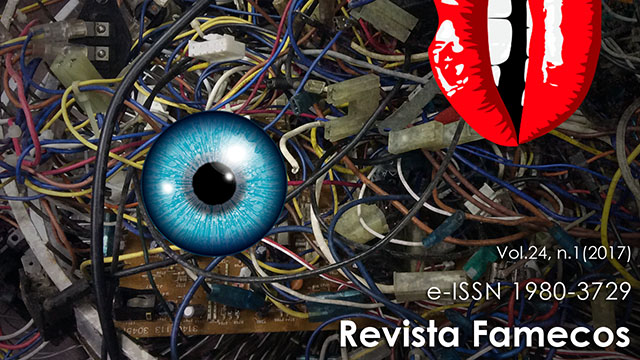Teorias normativas do jornalismo na Rússia: estado de origem
DOI:
https://doi.org/10.15448/1980-3729.2017.1.24742Palavras-chave:
Jornalismo, Teoria Normativa, Jornalismo RussoResumo
Teorias normativas do jornalismo são um objeto clássico de pesquisa. Nesta área existem abordagens e esquemas canônicos, que, no entanto, estão constantemente sujeitos a dúvidas e mudanças. O estudo histórico e teórico da experiência russa oferece uma oportunidade não só para ver interpretações originais do tema clássico, mas também oferecer abordagens não-tradicionais para a classificação das teorias normativas. O autor analisa as declarações e as práticas dos excelentes escritores, jornalistas e pensadores russos dos séculos XVIII-XIX, que estavam preocupados com o papel da imprensa na sociedade. Como resultado, surge a base para a identificação de três tipos de características normatividade para o jornalismo russo no passado e no presente. Ou seja, eles são: directiva, profissional-deontológica ou profissional-pragmática.Downloads
Referências
AKOPOV, A. First sociological research in the Russian journalism. In: Akopov, A. Some questions of journalism: history, theory, practice (articles of different years). Rostov-on-Don: Tura; Gefest, p. 201-207, 2002.
BAKULEV, G. Mass communication: Westernn theories and concepts. Moscow: Aspect Press, 2010.
BENSON, R. Journalism: normative theories. In: DOSBACH, W. (Ed.). The international encyclopedia of communication, v. VI. Malden, MA: Blackwell Pub., p. 2591- 2597, 2008.
DOBROLYUBOV, N. Provincial Sketches of Shchedrin. In: Essays by N.A. Dobrolyubov. v. 1. St. Petersburg: P. P. Soikin Pub., p. 341-364, 1900.
ESIN, B. Russian newspaper and the newspaper business in Russia. Moscow: Lomonosov Moscow State University, 1981.
FEDOTOV, M. Positive mass information law. In: RIHTER, A. (Ed.). Legislation of the Russian Federation on mass media. Moscow: Center “Pravo i SMI”, p. 295-540, 1999.
From the desktop of E. P. Prokhorov. In: PROKHOROVA, I. (Ed.).The book in memory of Professor E. P. Prokhorov: Scientific articles. Memories. Moscow: Lomonosov Moscow State University, p. 27-58, 2013.
GOROHOV, V.; DZYALOSHINSKY. Mass media: creativity and institutes. Mediascope, n. 4, 2012. Available in: http://www.mediascope.ru/node/1219
Access: 25 July 2016.
GROMOVA, L. A. A. Krajewski – editor and publisher. St. Petersburg: St. Petersburg State University, Pub., 2001.
______. Russian voice “from the other side”. In: KORKONOSENKO, S. (Ed.). Media in the modern world. St. Petersburg readings. St. Petersburg: Philological faculty, St. Petersburg State University, p. 202-206, 2012.
JAKUBOWICZ, K. Rude awakening: social and media change in Central and Eastern Europe. The Public, v. 8, n. 4, p. 59-80, 2001.
KRIVENKO, S. Newspaper business and newspaper people. In: ESIN, B.; MAHONINA, S. (Eds.). Selected pages of Russian journalism of the beginning of XX century. Moscow: CheRo, p. 141-146, 2001.
LAKATOS, I. History of science and its rational reconstruction. In: COHEN, R.; BUCK, R. (Eds.). Boston Studies in the Philosophy of Science, n. 8, p. 174-182, 1971.
MACHADO, E. From journalism studies to journalism theories. Brazilian Journalism Research, v. 1, n. 1, Semester 1, p. 11-23, 2005.
MAKUSHIN, L. Censors hip regime and the system of the Russian periodical press in the era of the great reforms of Alexander II. 2010. 492 p. Thesis (PhD in Philology) – Faculty of Journalism, St. Petersburg State University, St. Petersburg, 2010.
MCQUAIL, D. Journalism as a public occupation: alternative Images. In: CARPENTIER, N.; PRUULMANN-VENGERFELDT, P.; NORDENSTRENG, K. et al. (Eds.). Democracy, journalism and technology: new developments in an enlarged Europe: the Intellectual work of ECREA’s 2008 European media and communication doctoral summer school. Tartu: Tartu University Press, p. 47-59, 2008.
NERONE, J. The historical roots of the normative model of journalism. Journalism, v. 14, n. 4, p. 446-458, May. 2013.
NORDENSTRENG, K. The Russian media system: something special? In: VARTANOVA, E. (Ed.). Content, channels and audiences in the New Millenium: interaction and interrelations. Moscow: Faculty of Journalism, Lomonosov Moscow State University, p. 183-186, 2010.
NORDENSTRENG, K.; PIETILÄINEN, J. Normative theories of the media: lessons from Russia. In: ZASSOURSKY, YA. N.; VARTANOVA, E. (Eds.). Media, communications and the open society. Moscow: Faculty of Journalism/Publisher IKAR, p. 146- 159, 1999.
NOVIKOV, N. Experience of historical dictionary of Russian writers (excerpt). In: PIROZHKOVA, T. (Introd. article, comments, and notes). In the temple of memory. Literary-critical works of M. V. Lomonosov 1765-1865. Moscow: Lomonosov Moscow State University, p. 43-50, 2011.
SHERBAKOVA, G. Journal of O. I. Senkovsky “Library for Reading” (1834-1856) and formationof mass journalismin Russia. St. Petersburg: St. Petersburg State University Pub., 2005.
SJØVAAG, H. The meaning and function of journalistic ideology. In: TRIVUNDŽA, I.; CARPENTIER, N.; NIEMINEN, H.; et al. (Eds.). Past, future and change: contemporary analysis of evolving media scapes. Ljubljana: Faculty of Social Sciences, University of Ljubljana Press: Založba FDV, p. 131-145, 2013.
SLONIMSKY, L. Periodical press and capitalism. In: ESIN, B.; MAHONINA, S. (Eds.). Selected pages of Russian journalism of the beginning of XX century. Moscow: CheRo, p. 175-181, 2001.
TALOVOV, V. Origins of sociological journalistic studies in Russia. Vestnik Moskovskogo Universiteta. Series 10, Journalism, n. 5, p. 27-35, 1993.
______. The legislation of the Russian Federation on mass media and journalism. In: KORKONOSENKO, S. (Ed.) Social functioning of journalism. St. Petersburg: Chas Pik, p. 23-43, 1994.
ZHIRKOV, G. Interaction between journalism and journalism theory in Russia: from the 18th to the Early 20th Century. Russian Journal of Communication, v. 4, n. 3/4, p. 177-197, Summer/Fall, 2011.
______. Journalism: historical studes and portraits. St. Petersburg: Roza Mira, 2007.
Downloads
Publicado
Como Citar
Edição
Seção
Licença
Direitos Autorais
A submissão de originais para a Revista Famecos implica na transferência, pelos autores, dos direitos de publicação. Os direitos autorais para os artigos publicados nesta revista são do autor, com direitos da revista sobre a primeira publicação. Os autores somente poderão utilizar os mesmos resultados em outras publicações indicando claramente a Revista Famecos como o meio da publicação original.
Licença Creative Commons
Exceto onde especificado diferentemente, aplicam-se à matéria publicada neste periódico os termos de uma licença Creative Commons Atribuição 4.0 Internacional, que permite o uso irrestrito, a distribuição e a reprodução em qualquer meio desde que a publicação original seja corretamente citada.






